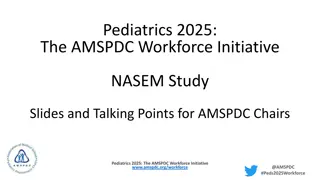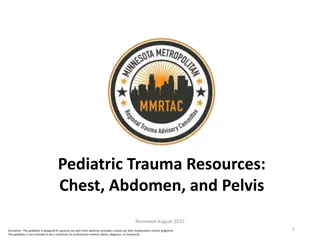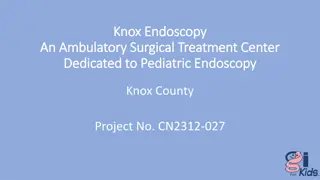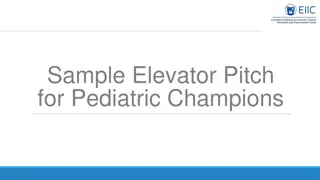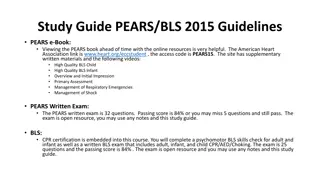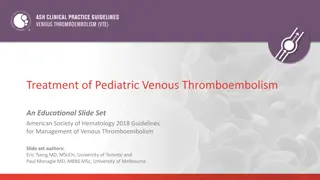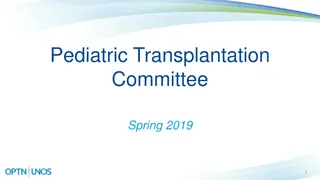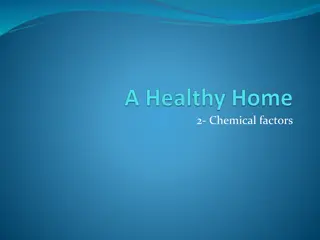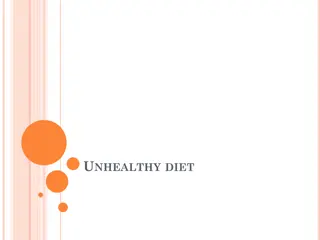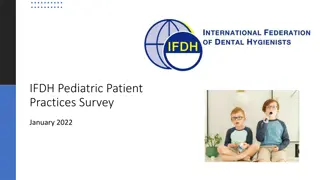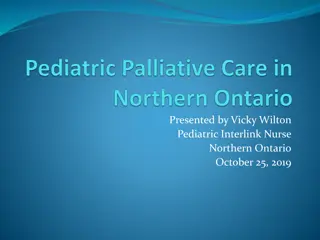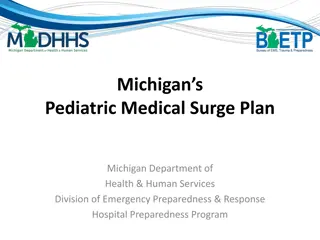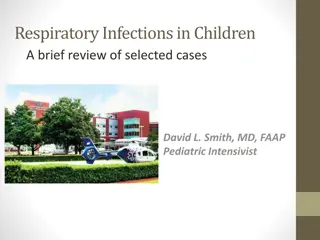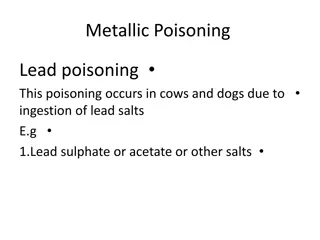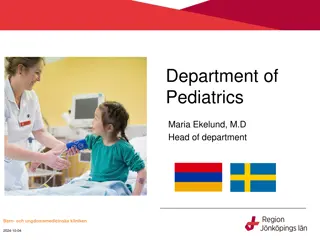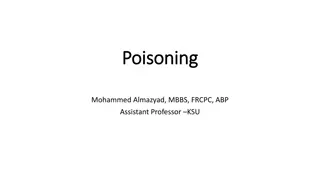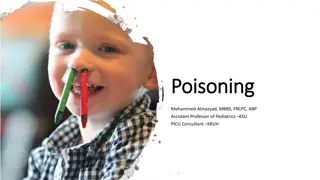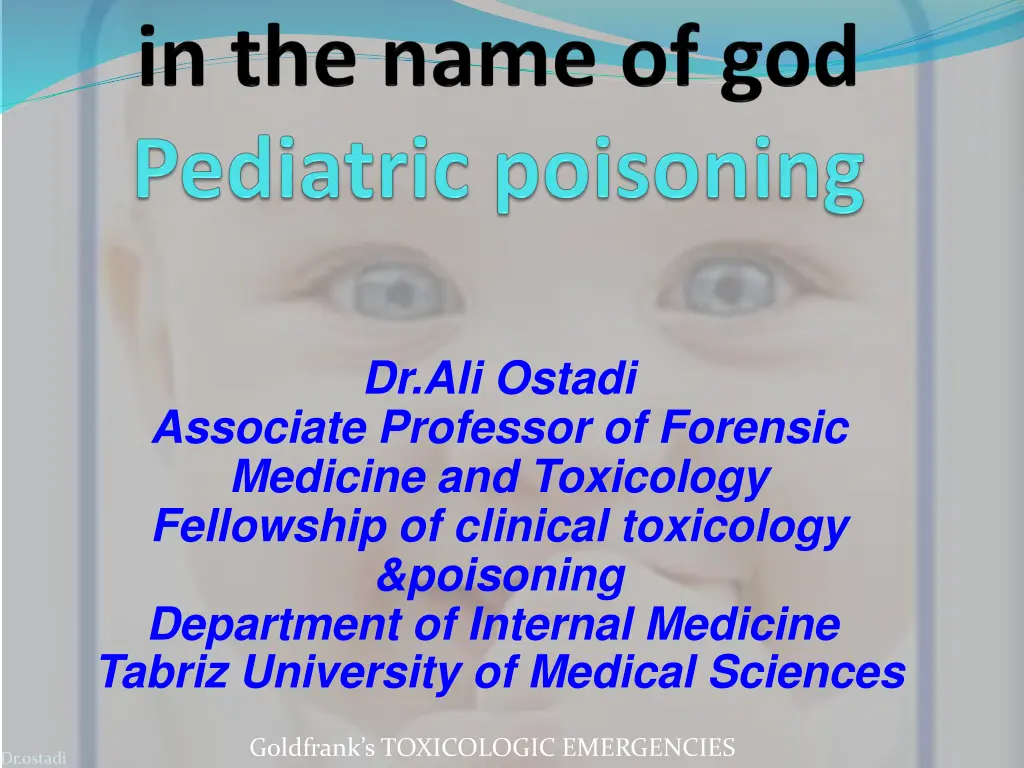
Pediatric Toxicology: Insights on Childhood Exposures and Fatalities
Gain valuable insights into pediatric toxicology, exploring the prevalence of toxic exposures in children and adolescents, common xenobiotics found in households, age-specific risks, and factors contributing to childhood fatalities. Learn about the significance of child abuse, unintentional ingestions, suicide, and environmental exposures. Stay informed about the trends, patterns, and preventive measures in toxicological emergencies among the youth.
Uploaded on | 0 Views
Download Presentation

Please find below an Image/Link to download the presentation.
The content on the website is provided AS IS for your information and personal use only. It may not be sold, licensed, or shared on other websites without obtaining consent from the author. If you encounter any issues during the download, it is possible that the publisher has removed the file from their server.
You are allowed to download the files provided on this website for personal or commercial use, subject to the condition that they are used lawfully. All files are the property of their respective owners.
The content on the website is provided AS IS for your information and personal use only. It may not be sold, licensed, or shared on other websites without obtaining consent from the author.
E N D
Presentation Transcript
Dr.Ali Ostadi Associate Professor of Forensic Medicine and Toxicology Fellowship of clinical toxicology &poisoning Department of Internal Medicine Tabriz University of Medical Sciences Goldfrank s TOXICOLOGIC EMERGENCIES Dr.ostadi
Each years ,the AAPCC reports approximately 1.6 million potentially toxic exposures in children and adolescents ages 0 to 19 years 65% of all 52%< 6 years Children and adolescents: 79% <6 years 10% 6-12 11% 13-19 Girls: children 47% adolescents 55% Goldfrank s TOXICOLOGIC EMERGENCIES Dr.ostadi
< 6 years 99% unintentional Adolescents 48% unintentional 118000 exposures Therapeutic errors 13000 exposures adverse drug reactions <6 years : 55% xenobiotics that are commonly found around the house : cleaning products ,cosmetics , plants, hydrocarbons , insecticides 45% pharmaceuticals Goldfrank s TOXICOLOGIC EMERGENCIES Dr.ostadi
6- 19 years 47% nonpharmaceuticals 53% pharmaceuticals Most hospitalization and death in both groups are caused by pharmaceuticals <1 years child abuse and neglect 1) Without suicidal intent 2) Usually one xenobiotic involved 3) Xenobiotic are usually nontoxic 4) amount is usually small 5) Usually present for evaluation relatively soon after ingestion Goldfrank s TOXICOLOGIC EMERGENCIES Dr.ostadi
Peak age 1-3 years 1959 456 death 1999-2005 85 Childhood fatalities: 35% unintentional ingestions 20 % environmental exposures(co) 16% therapeutic errors and adverse reactions 11% abuse 16% unknown Goldfrank s TOXICOLOGIC EMERGENCIES Dr.ostadi
Adolescent fatalites: 42% suicide 37% abuse or misuse 5 % environmental exposures 3% therapeutic errors and adverse reactions 13 % unknown Goldfrank s TOXICOLOGIC EMERGENCIES Dr.ostadi
History of the exposure Child abuse Number of pills or volume of liquid Suicide Goldfrank s TOXICOLOGIC EMERGENCIES Dr.ostadi
Children generally ingest small quantities of single xenobiotics Orogastric lavage Should never be used as a form punishment Intubation Syrup of ipecac Activated charcoal Goldfrank s TOXICOLOGIC EMERGENCIES Dr.ostadi
Hemodialysis Charcoal hemoperfusion Peritoneal dialysis Exchange transfusion Salicylates , theophylline , chloral hydrate Goldfrank s TOXICOLOGIC EMERGENCIES Dr.ostadi
One pill or one teaspoonful Benzocaine BAdrenergic antagonists(sustained release) Calcium channel blockers(sustained release) Camphor Clonidine Cyclic antidepressant Diphenoxylate and atropine(lomotil) Methanol or ethylene glycol Methyl salicylate Goldfrank s TOXICOLOGIC EMERGENCIES Dr.ostadi
Monoamine oxidase inhibitors Opioids Phenothiazine Quinine or chloroquine Sulfonylurea theophylline Goldfrank s TOXICOLOGIC EMERGENCIES Dr.ostadi
LOMOTIL SULFONYLUREA Goldfrank s TOXICOLOGIC EMERGENCIES Dr.ostadi
Benzyl alcohol : gasping syndrome Toxic dose: respiratory failure ,vasodilation , hypotension , convulsion , paralysis Gasping syndrome: in sick newborns : severe metabolic acidosis , encephalopathy , respiratory depression , gasping Imidazolines and clonidine :CNS effects CNS depression , respiratory depression , bradycardia , miosis , hypotension Goldfrank s TOXICOLOGIC EMERGENCIES Dr.ostadi
Ethanol : Hypoglycemia Mouth wash , perfume Reduced hepatic glycogen stores in children Chloramphenicol :Gray baby syndrome Abdominal distention , vomiting , metabolic acidosis , progressive pallid cyanosis , irregular respiration , hypothermia , hypotension , vasomotor collapse Goldfrank s TOXICOLOGIC EMERGENCIES Dr.ostadi
113000 exposure each year 2003-2007 26 death Ordering , order transcription , pharmacy dispensing , preparation and administration , monitoring Goldfrank s TOXICOLOGIC EMERGENCIES Dr.ostadi
1. Wrong patient someone else's drug 2. Wrong drug a. Wrong individual drug b. Wrong formulation c. Known allergy d. Known drug drug interactions e. Wrong indication f. Contraindication g. Expired h. Deteriorated Goldfrank s TOXICOLOGIC EMERGENCIES Dr.ostadi
3. Wrong dose a. Miscalculation i. Decimal point error ii. Wrong formula iii. Right formula using wrong dose, frequency, units, weight iv. Pound/kilogram confusion v. Mg/ g units confusion vi. Dilution error b. Appropriate individual dose divided into multiple doses c. Total daily dose for an individual dose d. Wrong IV infusion rate e. Measuring error Goldfrank s TOXICOLOGIC EMERGENCIES Dr.ostadi
4. Wrong route 5. Wrong frequency a. Increased/decreased dosing interval b. Omitted/delayed/added dose c. Delay/failure to supply 6. Transcription errors 7. Documentation (order, prescription, transcription, logs) a. Illegible b. Incomplete/missing information (weight, signature, maximum daily dose, stop date) Goldfrank s TOXICOLOGIC EMERGENCIES Dr.ostadi
Wrong drug formulation. Acetaminophen suppositories (120 mg) were ordered for a toddler, but adult-strength suppositories (650 mg) were distributed and administered every 4 hours. The child developed hepatotoxicity requiring hospitalization and therapy Wrong dose. A 1-kg premature infant required sedation for a diagnostic study. A high dose of chloral hydrate, 100 mg/kg, was miscalculated to be 1 g (1000 mg) instead of 100 mg. The child had a cardiopulmonary arrest and died. When drugs require milligram-per-kilogram dosing, it is easy to make decimal mistakes in the calculation or in the transcription. Goldfrank s TOXICOLOGIC EMERGENCIES Dr.ostadi
Wrong dose/wrong route. A recommendation was made to treat a baby with penicillin G benzathine, 50,000 U/kg IM. The recommendation was transcribed as penicillin G 50,000 units/kg. The order was handwritten as Benzathine Pen G 150,000 U IM but was misread or misinterpreted as 1,500,000 U IV. The patient had a cardiopulmonary arrest and died. Goldfrank s TOXICOLOGIC EMERGENCIES Dr.ostadi
(a) Someone other than the child; (b) a young child cannot warn practitioners about possible problems such as allergies; (c) a young child cannot inform practitioners when he or she is experiencing side effects; (d) (4) pediatric medication ordering and administration frequently requires dose calculations; (e) (5) inexperienced practitioners may be uncomfortable with pediatric dosing or related calculations; (f) (6) incorrect measurement of liquid preparations or dilution. Goldfrank s TOXICOLOGIC EMERGENCIES Dr.ostadi
The most common error attributed to physicians is prescription of an incorrect dose, particularly in children, where almost every prescription requires a determination of weight and calculation of the dose. The most commonly recommended solutions to reduce the frequency of medication errors are computerized physician order entry (CPOE) with clinical decision support systems, ward-based clinical pharmacists, and improved communication among physicians, nurses, and pharmacists Goldfrank s TOXICOLOGIC EMERGENCIES Dr.ostadi
there may be an increased risk of medication errors in critical care areas because of: severity of illness intensity of medication therapy. In many cases, such as during resuscitations, critically ill patients require immediate therapy, verbal orders are common, and there is often insufficient time to carefully review all of the particulars related to medication ordering and administration Goldfrank s TOXICOLOGIC EMERGENCIES Dr.ostadi
In fact, many parents have significant difficulty both calculating the appropriate dose of acetaminophen and measuring out the appropriate amount once calculated, despite having received appropriate instructions and graduated cups or oral- dosing syringes. The most commonly used measuring device is also the most inaccurate; the household teaspoon is not standardized for volume and can easily be confused with a household tablespoon Goldfrank s TOXICOLOGIC EMERGENCIES Dr.ostadi
Intentional poisoning of children is an unusual, though significant, form of child abuse. There are several types of intentional poisoning, some of which define pathologic characteristics of the caretaker: (1) undifferentiated child abuse, neglect, or impulsive acts under stress; (2) factitious illness (Munchausen syndrome by proxy); (3) overt parental psychosis; Goldfrank s TOXICOLOGIC EMERGENCIES Dr.ostadi
In addition to many pharmaceutical agents, salt, pepper, water, caffeine, ethylene glycol, herbs, plants, and traditional remedies have been used to poison children. Although the death rate from unintentional poisoning in childhood is much less than 1%, the death rate from inflicted poisoning may be as high as 20-30% Goldfrank s TOXICOLOGIC EMERGENCIES Dr.ostadi
Goldfranks TOXICOLOGIC EMERGENCIES Dr.ostadi
Child abuse or neglect is part of the differential diagnosis in any case of childhood poisoning. Intentional poisoning should be considered for (a) an ingestion in a child younger than 1 year of age; (b) a case with a confusing history or presentation; (c) a child with a previous poisoning or whose siblings have been previously evaluated for poisoning; (d) a child with a previous presentation for a rare or unexplained medical condition; Goldfrank s TOXICOLOGIC EMERGENCIES Dr.ostadi
(e) a child with apnea, unexplained seizures, or an apparent life-threatening event; (f) a massive ingestion by a small child; (g) an ingestion of multiple xenobiotics by a small child; (h) an exposure to substances of abuse; (i) an intoxication with a xenobiotic to which a child could or would not have access; (j) accidental ingestions in the school-age child; (k) a history of previous trauma, child abuse, or neglect; or (l) sudden infant death syndrome or an unexplained death Dr.ostadi
Goldfranks TOXICOLOGIC EMERGENCIES Dr.ostadi

